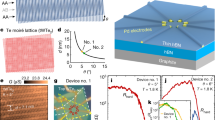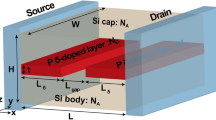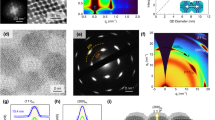Abstract
The size dependence of the bandgap is the most identifiable aspect of quantum confinement in semiconductors; the bandgap increases as the nanostructure size decreases1,2,3. The bandgaps in one-dimensional (1D)-confined wells, 2D-confined wires, and 3D-confined dots should evolve differently with size as a result of the differing dimensionality of confinement1. However, no systematic experimental comparisons of analogous 1D, 2D or 3D confinement systems have been made. Here we report growth of indium phosphide (InP) quantum wires having diameters in the strong-confinement regime, and a comparison of their bandgaps with those previously reported for InP quantum dots4,5,6,7. We provide theoretical evidence to establish that the quantum confinement observed in the InP wires is weakened to the expected extent, relative to that in InP dots, by the loss of one confinement dimension. Quantum wires sometimes behave as strings of quantum dots8, and we propose an analysis to generally distinguish quantum-wire from quantum-dot behaviour.
This is a preview of subscription content, access via your institution
Access options
Subscribe to this journal
Receive 12 print issues and online access
$259.00 per year
only $21.58 per issue
Buy this article
- Purchase on Springer Link
- Instant access to full article PDF
Prices may be subject to local taxes which are calculated during checkout





Similar content being viewed by others
References
Yoffe, A.D. Low-dimensional systems: quantum size effects and electronic properties of semiconductor microcrystallites (zero-dimensional systems) and some quasi-two-dimensional systems. Adv. Phys. 42, 173–266 (1993).
Efros, A.L. & Rosen, M. The electronic structure of semiconductor nanocrystals. Annu. Rev. Mater. Sci. 30, 475–521 (2000).
Yoffe, A.D. Semiconductor quantum dots and related systems: electronic, optical, luminescence and related properties of low dimensional systems. Adv. Phys. 50, 1–208 (2001).
Mícíc, O.I., Sprague, J., Lu, Z. & Nozik, A.J. Highly efficient band-edge emission from InP quantum dots. Appl. Phys. Lett. 68, 3150–3152 (1996).
Mícíc, O.I., Jones, K.M., Cahill, A. & Nozik, A.J. Optical, electronic, and structural properties of uncoupled and close-packed arrays of InP quantum dots. J. Phys. Chem. B 102, 9791–9796 (1998).
Mícíc, O.I., Ahrenkiel, S.P. & Nozik, A.J. Synthesis of extremely small InP quantum dots and electronic coupling in their disordered solid films. Appl. Phys. Lett. 78, 4022–4024 (2001).
Guzelian, A.A. et al. Synthesis of size-selected, surface-passivated InP nanocrystals. J. Phys. Chem. 100, 7212–7219 (1996).
Hasen, J. et al. Metamorphosis of a quantum wire into quantum dots. Nature 390, 54–57 (1997).
Dingle, R. Confined carrier quantum states in ultrathin semiconductor heterostructures. Festkörperprobleme XV, 21–48 (1975).
Harper, P.G. & Hilder, J.A. Exciton spectra in thin crystals. Phys. Status Solidi 26, 69–76 (1968).
Gudiksen, M.S., Wang, J. & Lieber, C.M. Size-dependent photoluminescence from single indium phosphide nanowires. J. Phys. Chem. B 106, 4036–4039 (2002).
Nanda, K.K., Kruis, F.E. & Fissan, H. Energy levels in embedded semiconductor nanoparticles and nanowires. Nano Lett. 1, 605–611 (2001).
Brus, L.E. Electron-electron and electron-hole interactions in small semiconductor crystallites: The size dependence of the lowest excited electronic state. J. Chem. Phys. 80, 4403–4409 (1984).
D'Andrea, A. & Del Sole, R. Excitons in semiconductor confined systems. Solid State Commun. 74, 1121–1124 (1990).
Lefebvre, P., Christol, P. & Mathieu, H. Unified formulation of excitonic absorption spectra of semiconductor quantum wells, superlattices, and quantum wires. Phys. Rev. B 48, 17308–17315 (1993).
Lefebvre, P., Christol, P., Mathieu, H. & Glutsch, S. Confined excitons in semiconductors: Correlation between binding energy and spectral absorption shape. Phys. Rev. B 52, 5756–5759 (1995).
Li, L.-s., Hu, J., Yang, W. & Alivisatos, A.P. Band gap variation of size- and shape-controlled colloidal CdSe and quantum rods. Nano Lett. 1, 349–351 (2001).
Kan, S., Mokari, T., Rothenberg, E. & Banin, U. Synthesis and size-dependent properties of zinc-blende semiconductor quantum rods. Nature Mater. 2, 155–158 (2003).
Tang, Z., Kotov, N.A. & Giersig, M. Spontaneous organization of single CdTe nanoparticles into luminescent nanowires. Science 297, 237–240 (2002).
Holmes, J.D., Johnston, K.P., Doty, R.C. & Korgel, B.A. Control of thickness and orientation of solution-grown silicon nanowires. Science 287, 1471–1473 (2000).
Trentler, T.J. et al. Solution-liquid-solid growth of indium phosphide fibers from organometallic precursors; elucidation of molecular and nonmolecular components of the pathway. J. Am. Chem. Soc. 119, 2172–2181 (1997).
Trentler, T.J. et al. Solution-liquid-solid growth of crystalline III-V semiconductors; an analogy to vapor-liquid-solid growth. Science 270, 1791–1794 (1995).
Markowitz, P.D., Zach, M.P., Gibbons, P.C., Penner, R.M. & Buhro, W.E. Phase separation in AlxGa1-xAs nanowhiskers grown by the solution-liquid-solid mechanism. J. Am. Chem. Soc. 123, 4502–4511 (2001).
Gudiksen, M.S., Wang, J. & Lieber, C.M. Synthetic control of the diameter and length of single crystal semiconductor nanowires. J. Phys. Chem. B 105, 4062–4064 (2001).
Wu, Y. & Yang, P. Direct observation of vapor-liquid-solid nanowire growth. J. Am. Chem. Soc. 123, 3165–3166 (2001).
Yu, H., Gibbons, P.C., Kelton, K.F. & Buhro, W.E. Heterogeneous seeded growth: a potentially general synthesis of monodisperse metallic nanoparticles. J. Am. Chem. Soc. 123, 9198–9199 (2001).
Yu, H. & Buhro, W.E. Solution-liquid-solid growth of soluble GaAs nanowires. Adv. Mater. 2003, 416–419 (2003).
Stuczynksi, S.M., Opila, R.L., Marsh, P., Brennan, J.G. & Steigerwald, M.L. Formation of indium phosphide from trimethylindium (In(CH3)3) and tris(trimethylsilyl)phosphine (P(Si(CH3)3)3). Chem. Mater. 3, 379–381 (1991).
Wang, L.-W. & Zunger, A. Solving Schrödinger's equation around a desired energy: Application to silicon quantum dots. J. Chem. Phys. 100, 2394–2397 (1994).
Fu, H. & Zunger, A. InP quantum dots: Electronic structure, surface effects, and the redshifted emission. Phys. Rev. B 56, 1496–1508 (1997).
Acknowledgements
The experimental work was funded by the USA National Science Foundation (CHE-0092735). The semiempirical pseudopotential calculations were supported by the USA Department of Energy (Contract No. DE-AC03-76SF00098), using the resources of the National Energy Research Scientific Computing Center. We thank P. C. Gibbons for helpful discussions.
Author information
Authors and Affiliations
Corresponding authors
Ethics declarations
Competing interests
The authors declare no competing financial interests.
Supplementary information
Rights and permissions
About this article
Cite this article
Yu, H., Li, J., Loomis, R. et al. Two- versus three-dimensional quantum confinement in indium phosphide wires and dots. Nature Mater 2, 517–520 (2003). https://doi.org/10.1038/nmat942
Received:
Accepted:
Published:
Issue Date:
DOI: https://doi.org/10.1038/nmat942
This article is cited by
-
Polymer-Assisted High-Resolution Printing Techniques for Colloidal Quantum Dots
Macromolecular Research (2021)
-
Low-temperature synthesis of micro- and nano-crystalline CuFeS2 polymorphs
SN Applied Sciences (2020)
-
Size and shape dependence of optical properties of nanostructures
Applied Physics A (2020)
-
Flexible quantum dot light-emitting diodes for next-generation displays
npj Flexible Electronics (2018)



